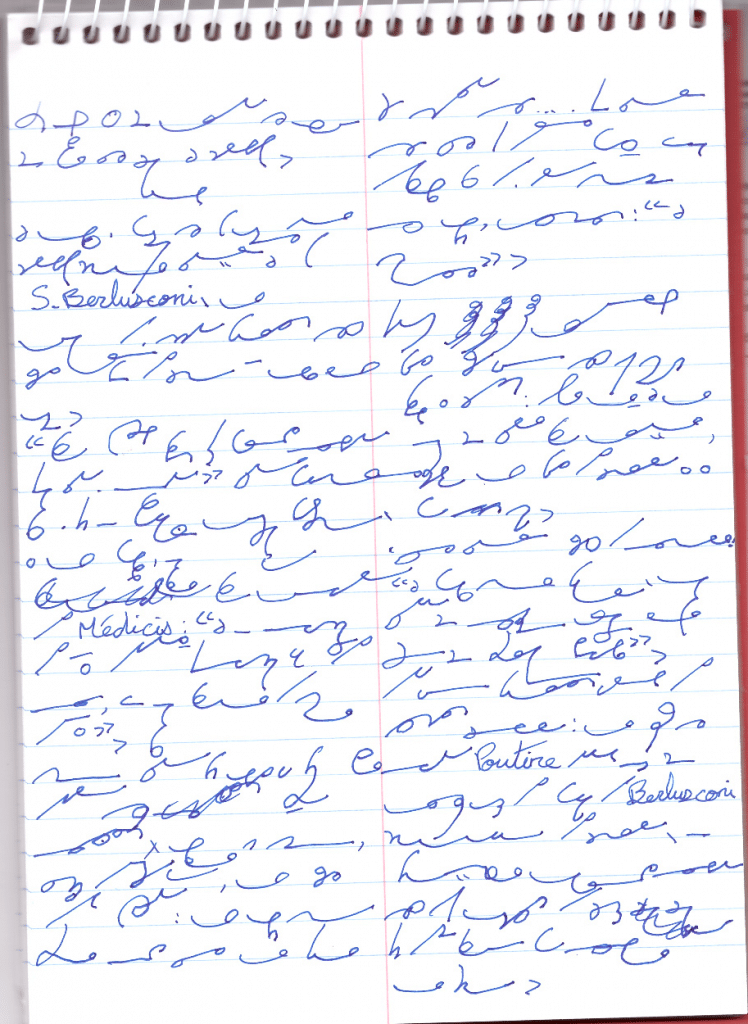Hello,
I hope everybody is doing well in these strange times.
I’m posting here a random piece on machismo in political figures. I’ve transcribed it on a steno pad which seems to be the right size (at least it’s the same size as Carlos’s texts). Yet I feel my writing is crammed and I have a hard time fitting more than 3-4 words on one line. Some words (like réglementation, which comes up quite often at work) take up a whole line when I don’t make an extra effort to write them efficiently.
So I’d like to receive some feedback and criticism on the form as well as the rules. I’ve kept it raw and a bit messy because I’ve noticed my writing becomes completely unnatural when I write something with the intention to share it afterwards. Thanks!

Nice to see you back posting, Aymeric! Your penmanship has improved considerably!!!
That's the correct paper size. I think that the issue is that in DJS and later series, and especially in French (also in Spanish), the outlines are longer (compared to say Anniversary), and you're trying to write too many outlines in one space, not leaving much space between them. For penmanship purposes, space the outlines a little more (leave a space about the size of a horizontal short stroke n/r/k), and drop the number of outlines (have at most 5/line). Even when the outline is just the word un, I'd leave more or less the same amount of space. Look at my Centennial Gregg posts as a guide: that should give you an idea. As an example, in the first line, I would have jumped to the second line after leader.
Bottom line: let the outlines "breathe", so to speak. It's more pleasing to the eye, and you'll be able to read them much better.
(By the way, incarne: n-k-a-r-n, no nk/ng stroke.)
Thank you Carlos!
It's encouraging that you think my penmanship is better, even though I really haven't done much over the last few months for lack of time, just scribbling a few notes at work. Maybe it's good to just let it sit for a while then.
Would you also recommend leaving a blank line between each line I write? Your transcriptions are not lined so I'm not sure how much vertical space you leave between each line. Your spacing looks bigger than mine but smaller than double-spacing.
I do feel like my proportions in general get really sloppy when I'm forced to write smaller.
Your proportions are much better. Making the a circle very small and the a larger makes a difference in legibility, and you're doing that.
The paper that I use for my transcriptions is indeed lined, but the lines are very faint and almost disappear once I scan the pages.
There's no need to leave a blank line. Once you add more space between the outlines, you'll see that you'll be able to write using all the lines without much trouble. That’s one of the reasons I said that it is important to copy the shorthand from the books with your best penmanship, so that you get used to write in the steno pad with the correct form.
Thank you Carlos, I’ll try to work on that.
Writing size varies widely. Somewhere on this site are samples from championship writers, and an article by ?Swem? about writing size. One sample is tiny. One is so large they special-ordered larger pads. One is very short but wide, another is square-er
Official Gregg ruled is 1/3" or 8mm or somewhere around there. Normal US college-ruled paper is just enough smaller to make a difference.
Writing too small can slow you down, since you have to be more precise. If N is 1mm, then M is 2mm, and 0.5mm difference brings you to the dreaded "which is it?" length.
For years I tried to single-space on college-ruled. "It's only a tiny bit smaller! It saves paper! Shrink everything down (good discipline!) or keep them the standard size — make B go a tiny bit above the top line, and P a bit below, and the top line is a guide. The words don't clash that much, honest." When I switched back to wide-ruled, everything shifted. Easier to write. Tidier. Fewer words going up or down too high.
I still single-space in my diary. Saving that bit of paper is hard-wired, sigh. A diary I never re-read feels like a waste already (even though it makes the rest of my life smoother). For practice or important notes, though, I double-space or use wide-ruled. Another benefit of the wider spacing is room to transcribe. I don't quite trust shorthand for important notes. (Yeah, yeah, I need to re-read my own writing — learn to read it faster, and see what I need to fix before (oops) the wrong way is hard-wired. Do as I say…)
See what your natural size is. Close your eyes and write on blank paper, or draw just a few lines on a page, so you don't adjust your size to fit between lines. There are many paper generating programs online that will print at the spacing you choose.
(I like French-ruled, aka Seyes, https://pinboard.in/u:CricketB/t:shorthand-paper. It divides the line into quarters. Calligraphy papers can get really complex.)
I've mentioned this elsewhere on this blog, but I'll repeat it here: Wide-ruled paper puts 11/32 inch between the lines, while Gregg-ruled uses 1/3 inch. These measures are extremely close; so much so that it makes no practical difference whether you use Gregg-ruled or wide-ruled. College-ruled, on the other hand, puts significantly less space between the lines.